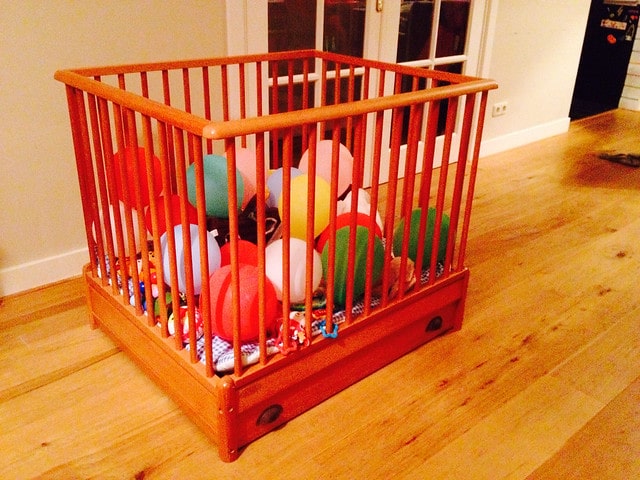
Image source: Flickr
The journey to parenthood is both exciting and exhausting. From the moment you get pregnant to every step of your child’s growth, you’ll have to make some very important decisions that will contribute to how happy, healthy and safe your child will be as he grows up.
Disclaimer: This post might contain affiliate links. In case you buy through these links, we might receive a small commission, which helps us operate this website. Learn more here.
One of the biggest decisions that you’ll have to make as a parent is to choose the right playpen for your child. The term “playpen” was first used in the Oxford English Dictionary in 1902 to refer to a piece of furniture where an infant of toddler could be placed to play safely while his guardian is pre-occupied with something.
Playpens have been used for many years, although there are still some debates on whether they are really safe or necessary.
So if you’re thinking about buying a playpen for your child, here’s everything that you need to know about it so you can make an informed decision.
The debate on playpens: Pros and cons
There has been a debate on whether a playpen is really a necessary investment or not.
A lot of parents are easily convinced that having a playpen at home is practical because it allows them to move around the house without worrying about their baby’s safety and it can also be used from infancy to early toddlerhood.
But some pediatricians and psychologists beg to disagree with the use of playpens.
Let’s take a closer look at some of the pros and cons of having a playpen at home:
The pros
- Safety
This is the primary and perhaps indisputable advantage of having a playpen in your house. Taking care of a baby or toddler is not an easy task and sometimes, your activities become limited just because you don’t want to leave your child on the bed or in his crib.
But when you have a playpen, you can put your child safely in it and have him play so you can do activities while he’s in sight.
This is especially useful as your baby gets active and would want to explore more because he has more space to move around while you’re nearby.
- Comfort
Unlike being stuck in a crib or a stroller that’s a lot smaller, your baby will be a lot comfortable being in a playpen where he can have some toys to play with and still have enough space to crawl, lie or even walk.
Some parents even take their playpens on picnics and family vacations because it’s much more comfortable for their child as compared to being placed in a bassinet or stroller.
- Convenience
If you’re alone in your house with the baby for most of the day, having a playpen will allow you to clean, cook and even do the laundry while your baby is safely near you.
A playpen is easier to fold and pack as compared to a crib, so you can set it up in the living room during the day and move it around the house conveniently whenever you need to.
This way, you can still do your daily activities without having to worry that your baby is left alone in his room.
- Independence
A lot of parents who use playpens love how their child becomes independent while spending time on it. Being in a crib can sometimes make your baby feel separated from the rest of the house, but being in a playpen allows him to be in the same space as you without any of the risks.
You don’t have to worry about a crawling baby putting his fingers in sockets or getting injured by sharp corners because he is confined within the safety of a playpen without making him feel too constricted.
The cons
- Isolation
Perhaps the biggest argument of medical experts about using a playpen is the isolation that could affect the baby’s emotional and mental development.
Some doctors say that while a playpen is spacious enough for the baby to move around independently, the isolation and restriction of freedom could have a profound effect to his mental growth, especially when he’s left in the playpen alone for hours.
If used only for a shorter period of time, a playpen offers a safe haven for your baby to be in while you get some chores done. The important thing here is to make sure that you don’t leave your baby inside the playpen by himself for hours.
Only use the playpen when it’s absolutely necessary and never leave your child unattended to avoid any dangers. Remember that a playpen should never be a substitute for adult supervision.
Choosing the right playpen
Now that you’re ready to invest in a playpen for your child, make sure that you’re choosing the right one by keeping these tips in mind:
- Look for the Juvenile Products Manufacturers Association (JPMA) certification label on the product. This means that the playpen was designed to meet the safety standards of the Consumer Products Safety Commission (CPSC).
- If you choose a playpen with mesh sides, make sure that the holes should not be larger than ¼ inch (0.6 centimeters) to protect your baby’s fingers from getting caught. It should also be securely attached to the rest of the playpen to avoid any accidents in the future.
- The ideal size for a playpen should be at least 21 inches (51 centimetres) high measured from its floor.
- If you’re going for a wooden playpen, make sure that the slat spaces should not be more than 2-3/8 inches (5.08 centimetres) in width.
- Look for a playpen that has pads on the top of its rails to keep your baby safe from bumps. The top rails should also lock automatically when lifted into the normal position. You should also make sure that the hinges and supports are strong and well protected.
- The bottom of the playpen should have at least a 1-inch firm pad or mattress to protect your baby.
Using the playpen safely
Once you already have a playpen at home, make sure that you are using it safely to protect your child from any dangers.
For one, you should never leave the baby in a mesh playpen alone with the sides lowered because he could get trapped and suffocate.
Also, never put any pillows in the playpen and never replace the padding or the mattress that comes with the playpen because it might not fit the space properly.
It’s also very important to place the playpen in a space that’s away from the windows or near blinds, sockets or any cords that could strangle the baby.
Of course, make sure to check the playpen every now and then for any tears, breaks or any other damages that could pose a hazard to the baby.
The takeaway
So, should you get a playpen for your baby? It all depends on your lifestyle and how well you can supervise your child while he’s inside the playpen.
Again, keep in mind that a playpen should never be your substitute for watching over your child. As long as you use it safely, having a playpen at home could be beneficial for you and the rest of the family.



